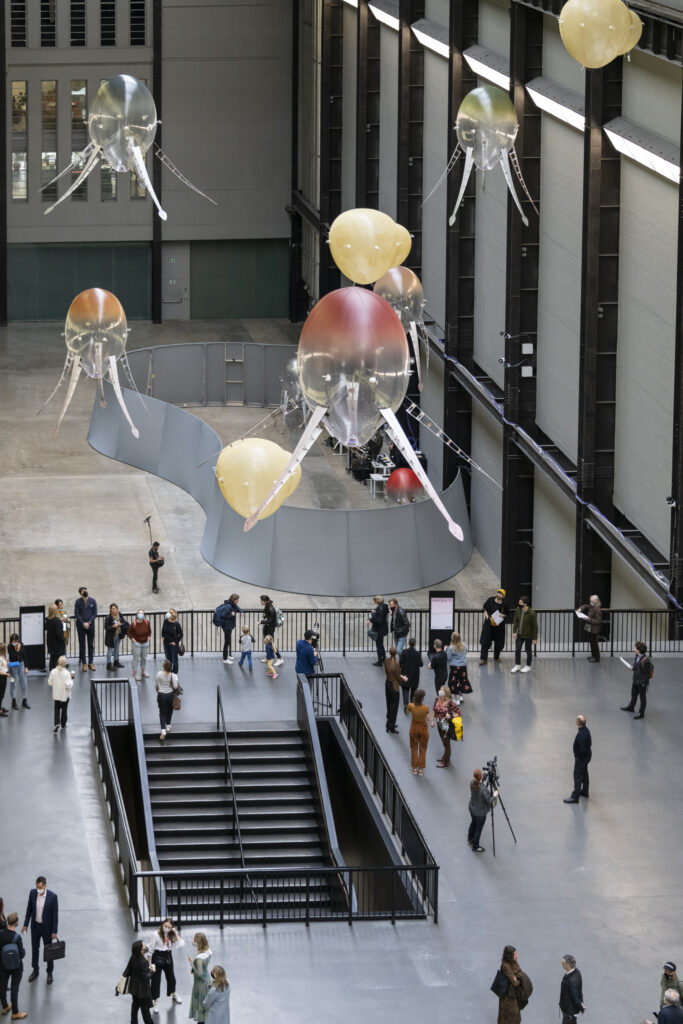By Amelia Casey-Rerhaye, BA Arabic
At long last the annual Hyundai Commission has returned to the Tate Modern’s beloved Turbine Hall, after an empty two years. Anicka Yi’s ‘In Love With The World’ – open to the public from the 12 October 2021 until the 16 January 2022 – does not disappoint. Yi’s biggest and most ambitious project to date features bulbous jellyfish-like machines meandering through the expansive space, seemingly with a mind of their own.
The floating objects, coined ‘aerobes,’ come in two shapes: ‘Xenojellies’ have a clear rounded body with coloured tops and agile tentacles, and ‘planulae,’ rounded bubble-like forms with tiny yellow hairs covering their surface, much like a cow’s hide. The mind-boggling aerobes inhabit the echoing hall all-day and can be best observed from the first floor bridge.
The immediate sensation as one walks along the ground floor of the hall looking up at the bobbing bodies above, is that of being at the bottom of an ocean or the inside of an immense aquarium. The design of the aerobes was based on ocean life forms and mushrooms, and are the result of trying to merge biology and machinery to break down the barriers between plants, life, and technology.

As I lost myself in the gentle movements of the individual tentacles, it was evident that the project had been executed exquisitely. Watching the conscious-like behaviour of the aerobe’s movements prompts the viewer to wonder what the future of technology is. Could machines evolve to be independent from human life? What are the possibilities for artificial intelligence?
Anicka Yi was born in Seoul in 1971 and now lives in New York City. She is a conceptual artist who likes to explore a range of materials that not only engage the vision, but all five senses in an attempt to push boundaries of comfort and understanding. Yi has been the subject of many solo exhibitions over the past decade. Her exhibition in 2016 at the Solomon R. Guggenheim Museum in New York City had two pieces, one of which presented a colony of ants under plexiglass on top of a representation of a server rack.
Her work is most often interdisciplinary. Through collaborating with specialists from a range of fields, Yi successfully fuses technology, art, philosophy, and anthropology resulting in thought-provoking and nuanced exhibitions.
Integrated into the commission are scentscapes. Changing every week, they expose the audience to the smells that have masked the area that is now bankside over the course of the earth’s history. Yi’s use of air as a material completes the immersive experience. The air around is made tangible by the fluid rhythmic motions of the aerobes through the perfumed space. Its added presence is slightly disconcerting given the current circumstances, however it also prompted me to explore the idea of air as a ‘thing’ rather than ‘nothing’. Through the incorporation of air in the commission, the step to considering ‘air politics’ is easy in a time when we are all hyper-aware of the air we share. Subjects such as pollution, the climate crisis, the pandemic, what air is and to whom it belongs are all quick to come to mind. The opening week’s scent was Cholera, a darkly ironic link to London’s history that we all noted in the press conference.
An experience akin to stepping into a rainforest or scuba-diving around a coral reef
The commission as a whole is mesmerising. Whether on your way to an exhibition or looking for a peaceful place to take a break from the city, I urge everyone to take a minute to watch the ethereal aerobes, as they explore the space into which they have been released. Yi and her team have created something truly spectacular, using four dimensions to expose the audience to an experience akin to stepping into a rainforest or scuba-diving around a coral reef.
As I stood, lost in the wonders of the artificial ecosystem in front of me, and listened to the sounds of machines fill the hall once again – albeit probably a little softer than those produced by the turbine that once filled the space – it was impossible to ignore the significance and beauty of the art in front of me.
Caption: ‘The mind-boggling aerobes inhabit the echoing hall all-day’. Anicka Yi, In Love With The World at the Tate Modern. (Credit: Joe Humphrys)
